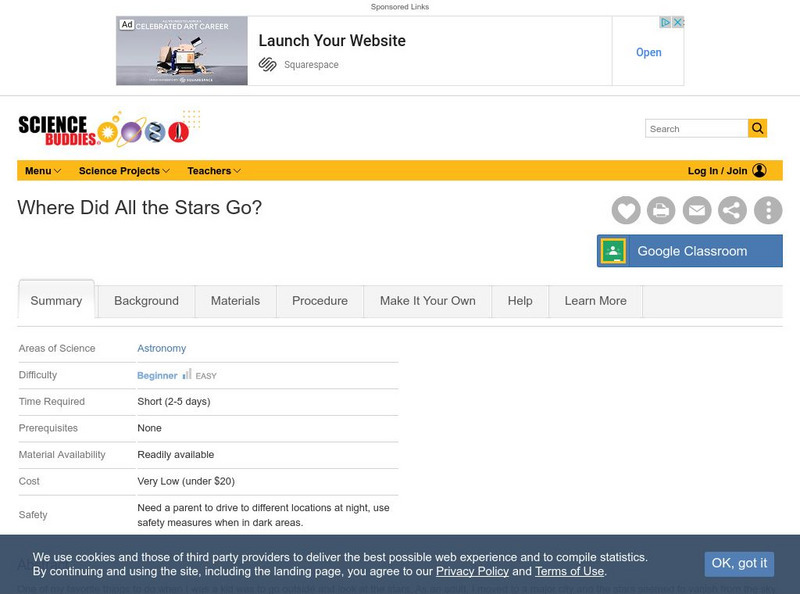Curated OER
Too Bright at Night?
Students reflect upon the causes and effects of light pollution in the night skies. First, they read articles provided and then do worksheets that are provided. They work in groups to discuss their conclusions.
Curated OER
Too Bright At Night?
Students explain what causes light pollution and how it can be curtailed. They consider the negative consequences of nighttime lighting, enabled by the invention of electric lights at the close of the 19th Century.
Curated OER
Light Pollution
In this light pollution learning exercise, students use a code to decode a message about light pollution. They name two things that can be done to reduce light pollution.
Curated OER
Too Bright at Night?
Students explore the consequences of light pollution. They consider benefits and drawbacks of technology in order to acquire informed attitudes on the various technologies and their social, cultural, economic, and ecological consequences. .
eSchool Today
E School Today: Your Cool Facts and Tips on Light Pollution
What is light pollution and why should we care about it? Learn what it is, the different types, sources of this type of pollution, the impact it has, and ways to combat it.
Encyclopedia of Earth
Encyclopedia of Earth: Health Effects of Light Pollution
Article discusses the impact of light pollution on the health of human beings as well as on plants and wildlife. (Updated July 18, 2012)
California Institute of Technology
Caltech Astronomy: Light Pollution and the Palomar Observatory
Learn about light pollution, how it is created, and it's negative impact on astronomical observatories, in particular, the one on Palomar Mountain, California. From the Caltech astronomy department this is an informative look at the...
Science Buddies
Science Buddies: Where Did All the Stars Go?
If you live in a big city or urban area it is hard to see many stars at night. In most urban areas only the most brilliant stars, planets and the moon can be seen. This is because of something called light pollution which is the...
TeachEngineering
Teach Engineering: Measuring Light Pollution
Students are introduced to the concept of light pollution by investigating the nature, sources and levels of light in their classroom environment. They learn about the adverse effects of artificial light and the resulting consequences on...
BSCS Science Learning
Bscs: Globe at Night Dark Skies
In this inquiry, students predict the best place to stargaze in Arizona based on the brightness of the night sky. Students are introduced to the concept of light pollution and Globe at Night, a global citizen science project in which...
BSCS Science Learning
Bscs: Global Night Sky Comparison
This inquiry invites students to investigate human impacts on the environment. Specifically, students will examine the relationship between human population, light pollution, and how brightly celestial objects like stars appear in the...
BSCS Science Learning
Bscs: Globe at Night Dark Skies
In this inquiry, students predict the best place to stargaze in Arizona based on the brightness of the night sky. Students are introduced to the concept of light pollution and Globe at Night, a global citizen science project in which...
Other
Bscs: Globe at Night Dark Skies
In this self-directed lesson, young scholars investigate what contributes to light pollution using data from locations around the globe. A handout with everything the student needs to complete this lesson is available as a PDF or Google...
American Institute of Biological Sciences
Action Bioscience: Light Pollution and Ecosystems
This article and the resources it provides explains how artificial outdoor lighting wreaks havoc on wildlife.
Environmental Education for Kids
Eek!: Be the Change: Light Pollution?
Light pollution is a particular concern in urban areas as people cannot enjoy looking at the night sky and all this light is being wasted.












